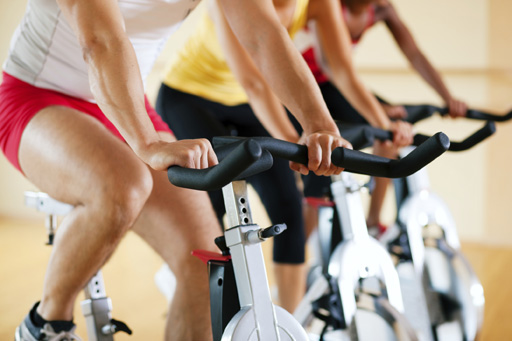
As the music gets louder, you pedal faster. The sweat pours, your muscles burn (in a good way). All in all you’re getting a great workout. But what about the noise? What if in addition to body soreness, your ears are ringing after you leave your spin class?
Dr. Elliott Kozin, an otolaryngologist and a clinical fellow of neurotology at Harvard Medical School, recalls a couple family members complaining about just that after a spin class. “They noted that the noise in the class was extremely loud — almost to the point of deafening, like being at a concert,” he says. “From that story — from family members — we had the idea to test or essentially measure the hearing levels of various cycling classes around the Boston area.”
The subsequent research Kozin helped conduct, published in the medical journal The Laryngoscope in 2016, found average sound exposure for one 45-minute spin class far exceeded the maximum noise exposure suggested for an eight-hour workday by the National Institute for Occupational Safety and Health. “The study that we performed found that the dose of noise one individual experiences during a cycling class exceeds the allowable dose of noise over an entire workday that NIOSH recommends,” says the study’s senior author Dr. Aaron Remenschneider, an otolaryngologist and an assistant professor of otolaryngology at the University of Massachusetts Medical School. Particularly for a person going to the gym several times a week, Remenschneider says, “that’s enough of a noise exposure to put them at risk of hearing loss.” The average noise level in 15 spin classes where sound was recorded was 113 dBA, or A-weighted decibels, a unit commonly used to describe sound levels. NIOSH recommends no more than 15 minutes of exposure at 100 dBA per day.
[See: 7 Health Hazards of Everyday Noise.]
Other research has also found noise levels in fitness classes, from spin to aerobic, exceeded maximum levels thought to be safe for hearing health. The researchers in The Laryngoscope study used smartphone-based mobile technology to measure noise exposure, a consumer-friendly approach to monitoring hazardous noise levels. Subsequently, some fitness class participants, including reporters, have taken the baton and used smartphones to measure unsafe high noise levels in fitness classes. Aerobics classes and gyms in general have gotten periodic attention, along with the focus on spin classes, and “I think there has always been some awareness that these can be quite loud locations,” says Colleen Le Prell, head of the audiology program at The University of Texas at Dallas.
But what’s changed is that now people have the ability to more precisely measure the threat in the palm of their hand with smartphones. Free apps like the NIOSH Sound Level Meter app allow people to check on a hunch that a fitness class might be toxically loud. Just follow app instructions, and make sure devices are properly calibrated to get accurate readings. If that’s not done, “it’s like getting on a scale that nobody ever really set the zero point correctly on,” says Deanna Meinke, a professor of audiology at the University of Northern Colorado and co-director of Dangerous Decibels, a public health campaign that targets noise-induced hearing loss.
Based on research, she says Apple iPhone products work best for monitoring loud noise, because the microphones are standardized across devices. “For Android devices, they are all different,” Meinke says, though Android users can still measure sound in fitness classes if everything is properly calibrated and in sync. “You’ve got to have a device, an operating system, a microphone, and everything that’s all calibrated working together,” she says.
Meinke questioned whether the readings found in the 2016 spin class study didn’t potentially overestimate the noise levels — though she doesn’t question the validity of general findings that noise levels are higher than the recommended maximum. The researchers used a smartphone and they turned it upside down, so the microphone would be pointing outward to record sound levels. “Which is good, except that’s in the cup holder of the bike — it’s not by the person’s ear — and some of those bikes actually have speakers in the bike itself.”
[See: How Music Helps People With Alzheimer’s Disease.]
But researchers assert in the study that if anything sound measurements “may have been subject to shadowing effects from equipment and may therefore have underestimated noise exposure.” Sometimes objects — in this case exercise equipment — may block or absorb a sound wave. However, the researchers add, “Future studies may employ external microphones to allow microphone positioning closer to the ear.” Regarding the study’s design, Kozin says, “we had people sit in different areas around the various cycling classes. Some were close to speakers. Some were far away from speakers. It was completely random. And if you’ll note the cup holders are within less than two feet, maybe even closer to 12 inches away from … the participants’ ears — you’re sort of leaning over. So I don’t think that the noise level would have dissipated within that short a span.”
Of course one loud class may not seem like much. But experts say it’s important to consider it in context. Go regularly to loud fitness classes, and if you’re exposed to lots of noise in other facets of your life — as people routinely are in the bustling modern world — it can add up and have a cumulative affect that contributes to noise-induced hearing loss. “What’s safe for one person may be not safe for another person. Because if one person works a noisy job or rides a motorcycle or shoots firearms … they’re going to be more at risk than somebody who works in a quiet office all week long,” Meinke says. “So people have to think about it in terms of their own overall exposure, not just in that one class.”
Past research indicates that temporary physiologic changes during exercise, like a fluctuation in body temperature, may leave the auditory system more vulnerable to noise-induced damage, though more study is needed to determine this.
It’s not just class participants who may be in harm’s way, either. Instructors who spend even more time in classes are particularly at risk.
Experts say those attending loud fitness classes basically have three options: Ask that the volume be turned down — which could be an uphill battle; wear ear protection like earplugs; or stop going to the class and find another way to get your workout that’s also more conducive to hearing health. “There’s definitely studies that show that music helps with the exercise,” Meinke says. It’s been found to help enhance workouts. But what’s not clear is if it’s the volume of the music or another element, like namely the tempo, that helps, she notes.
[See: How to Find Quiet in a Noisy World.]
Based on the risks, experts say, it’s worth experimenting with not so loud (even if not quiet) ways to maximize your workout. Watch the noise piped into earbuds on those solo runs or bike rides outside, too. “One of the issues beyond potential injury to the ears is just awareness of environment when you’re out on roads or somewhere else — being able to hear if there’s a car coming, and being able to stay engaged,” Le Prell says. “If you take your earbuds out and your ears are ringing, if you take your earbuds out and things sound muffled, it’s the exact same concern as with spin class, where you need to worry about turning down those sound levels, so that you don’t cause permanent damage with the repetition of those experiences.”
More from U.S. News
Causes of Hearing Loss Beyond Loud Noise
How to Get Your Fitness Groove Back
Is Your Spin Class Bad for Your Hearing? originally appeared on usnews.com







